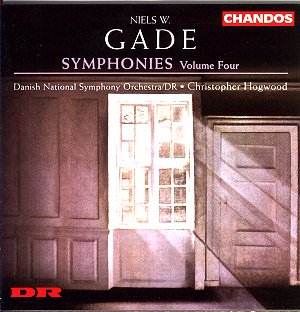Niels Gade is the first Danish symphonic composer of
any real significance. He composed eight symphonies throughout his career.
His first essay, the Symphony No.1 in C minor Op.5 "Paa Sjølunds
fagre Sletter" was written in 1842 and is quite an achievement
for a young composer (he was twenty-five when he completed it). He submitted
the work to the Copenhagen Musical Society for performance but the work
failed to win the Society’s approval. A friend of Gade offered it to
the Leipzig Gewandhaus Orchestra where it attracted Mendelssohn’s attention.
Mendelssohn conducted the first performance in Leipzig to great acclaim,
and Gade was invited to conduct a second performance, with similar success.
Gade’s models were Spohr and – more importantly, I think – Mendelssohn.
This first symphony is remarkably assured in its handling of the basic
material stated at the outset of the first movement, actually from an
earlier song composed in 1840 beginning with the words Paa Sjølunds
fagre Sletter ("On Zealand’s fair plains"). Many other
motifs are related to this simple, almost folk-like opening phrase,
which is the mark of a born symphonist. The music unfolds effortlessly
and resourcefully without a dull moment. It is full of arresting ideas
handled throughout with mastery and superbly scored. A quite ambitious
and undoubtedly successful first essay in symphonic thinking.
Composed ten years later as a wedding present to his
wife, the daughter of the composer J.P.E. Hartmann, the Symphony
No.5 in D minor Op.25 is still more assured and innovative,
including an important piano part. The work, however, is definitely
no concerto, but rather a symphonic work with piano modelled on Litolff’s
Concertos Symphoniques and hinting at some later similar
works such as d’Indy’s Symphonie cévennole. Indeed,
the piano does not stand out in isolation, but is part of the whole
symphonic fabric adding its own tonal palette to that of the orchestra
rather than competing with it. On the whole, the Fifth Symphony is more
relaxed and light-hearted, though it has its darker or more imposing
moments. It is interesting to note that the instrument chosen for the
present recording is an Erard piano made in 1837 rather than a traditional
concert grand and that the orchestral strings have been reduced in number
for the sake of balance. This pays high dividends, enhancing the intimate
mood of much of the music.
This is the fourth and last instalment of Chandos’s
recordings of Gade’s symphonies. I have not heard the earlier volumes,
but this one is quite attractive and enjoyable, superbly played and
warmly recorded.
Hubert Culot
SYMPHONIES
Volume 1
Symphony no.2 in E, op.10; Symphony no.8 in b, op.47
Volume
2 Symphony no. 4 in B flat, op. 20 Symphony no. 7 in F, op. 45 Concert
Overture no. 3, op. 14
